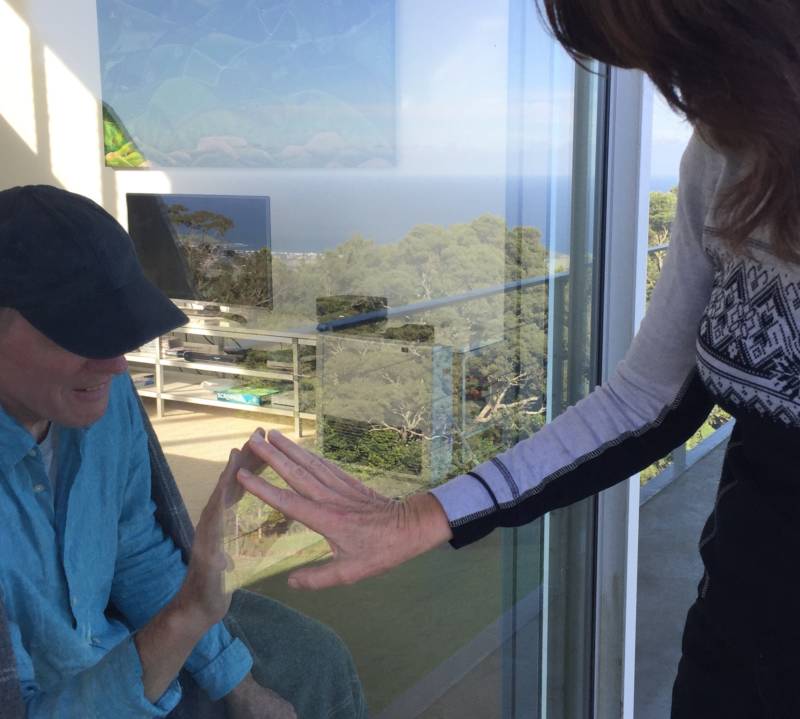
As Australia’s Prime Minister Scott Morrison announced an ‘early mark’ for Australians on social distancing restrictions from Saturday 2 May, 2020, because of our success in controlling Covid-19, the spotlight stays on the continuing sources of outbreaks – including aged care facilities.
Scrutiny will ensure we don’t have a sudden surge of new cases, as happened in Singapore. There, figures falling down to 1,000 at the beginning of April suddenly skyrocketed to more than 15,000 by the end of the month.
In Sydney it’s now suggested that Newmarch House workers could have mis-used personal protective equipment even if unintentionally, so breaching infection control and allowing the virus to spread.
Aged care involves close community living. It’s a scenario vulnerable to the spread of any infection, but especially Covid-19.
Yet we have a paradoxical problem in this setting: the greatest risk of infection coupled with the greatest tendency to see the elderly as the ‘other’; to want to detach from this group and fight Covid-19 infection in these clusters with loud, symbolic gestures but from a big distance.
These gestures are already threatening to depersonalise death in this setting – something Australian attitudes divide over – you’re either deeply distressed hearing stories of the isolated elderly dying, or one of those who argue this is the price to be paid to protect the community, especially in an age group so close to the end of life anyway.

Evidence of this disconnect in the way aged care facilities are perceived everywhere is highlighted by the extraordinary revelation that only now is the UK including death figures from aged care facilities in its Covid-19 death count.
This has been justified by foreign secretary, and until recently acting prime minister, Dominic Raab, as logistically difficult because the UK didn’t have the capacity to extend testing for Covid-19 to aged care facilities.
But that’s revealing. Because if you don’t test you don’t see, and if you don’t see you don’t know. How can a whole sector of a community be ignored? How can that help the whole community? This doesn’t bode well. If the BBC coverage of a London School of Economics report is true, forty per cent of the next round of Covid-19 cases in Europe will come from aged care facilities.
Across Australia, the recorded cases of Covid-19 in aged care facilities is encouragingly low. Just 63 out of 6767 cases by the time we eased the lockdown on Saturday.
However, on Saturday morning, Newmarch House, which had already reported 13 deaths by then, reported two new infections among workers. This following three new infections among workers on Friday.
By Tuesday, there had been 16 deaths, 23 residents who tested positive and 29 staff who tested positive.
This is despite “strict procedures and enforced infection control practices”.
But statements that Newmarch House believes these infections are all the result of earlier exposure only now being played out, are undermined by the constancy of the new numbers.
And this has wider implications, undermining the suggestion that infection control is as good in aged care facilities as it is in hospitals. Especially when we consider that there is now a fresh outbreak of Covid-19 at Melbourne’s aged care facility Hawthorn Grange.
Newmarch House

Some public hospitals in Sydney, which have much higher foot traffic than aged care facilities – some as many as 20,000 people in them at any one time – are currently proudly promoting the success of their infection control strategies, where not one other person has been infected by Covid-19, by the Covid-19 patients entering their facilities.
But by Saturday at Newmarch House, more than 60 people — 24 staff and 37 residents – had tested positive to Covid-19 since their outbreak started on 11 April.
Commonwealth Chief Medical Officer Brendan Murphy has announced expansion of “cohort testing” for Covid-19, that is testing among groups deemed to be at highest risk of catching and spreading the virus, even if they have no symptoms.
In response to the fault lines aged care facilities have exposed, aged care workers and hospital staff will be given high priority in this band.
This is a good development for aged care facilities, their residents, their families and their workers. But it has been a rocky road to get there, and the issue way too politicised.
Many doctors argue that the division in Australia, which means aged care facilities are controlled by the federal government, and state government’s control the public hospital system, creates problematic turf wars and gaps. Some issues are overlooked and some are contested by competing bureaucrats, jostling for ownership.
The powerlessness of the NSW government to fix the Newmarch House problem, despite NSW Premier Gladys Berejiklian’s repeated press conferences on the topic, was exposed to Good Grief!, when we put a set of questions to the NSW Health Department last week, only to be told, although informally: “It’s a Federal Government responsibility.”

Anglicare’s media relations officer Chris Pettett would not make any comment.
Instead he referred us to the professional organisations that cover aged care facilities, Leading Age Services Australia (LASA) and Aged and Community Services Australia (ACSA). We’ve asked for their comments and we look forward to speaking to them.
As large numbers of its workers went into isolation, Newmarch House was initially short staffed, something that could not have augured well for infection control. A similar situation happened at Dorothy Henderson Lodge in Sydney when the first cases in its cluster were reported. There, ultimately 21 residents and staff tested positive and six died.
LASA and ACSA asked for a ‘rescue package’ from the federal government for Newmarch House, and all other aged care facilities facing staff shortages amid the Covid-19 crisis.
Their statements both say:
· “We need a national approach for visits in aged care homes that respects the need for strong infection control, balanced with the needs of our residents for social and emotional supports provided by their friends and families.”
· “To implement this, we need the resources outlined in the aged care Rescue Package that the aged care sector has been calling for over recent weeks.”
This rescue package is $1.5 billion of funds to cover the ballooning costs of complying with Covid-19 safety measures.
In an industry under financial pressure to keep costs down yet deliver services humanely, many fear being infected by the families of residents. Even though the sources of infection in the two major aged care facilities’ outbreaks in NSW did not come from family visitors, aged care facilities have been under pressure from their workers not to allow families in.
Whether or not this is the reason, Newmarch House chose to go into stringent lockdown.
But while this was happening, management of the families of residents became – and remains – one of the most contentious issues in the way the Newmarch House Covid-19 outbreak was managed.
On a number of occasions, both the NSW Premier and the Prime Minister were reported criticising the management’s communication with residents’ families.
And on Friday 1 May, Premier Berejiklian called on aged care home operators to better manage visits by families, echoing words expressed by Prime Minister Scott Morrison, starting a week earlier and reiterated again on 29 April.
The Premier had previously told Newmarch House to “lift its game” in relation to this.
Palliative care in this context

“The grief associated with death is a deep and profound thing and it can be compounded when there is regret over loss of control or it has happened unexpectedly. This makes it harder for families to deal with and this is one of the challenges of the pandemic,” said Adelaide’s Professor Gregory Crawford, President of the Australasian Chapter of Palliative Care Medicine.
Currently access of families to dying patients, both in aged care facilities and hospitals across Australia, and indeed the world, is being limited.
But some medical specialists are challenging this, saying that with high quality personal protective equipment, and more lateral thinking, families should be able to visit, touch and even hold their dying family member, both in hospitals and aged care facilities.
“I understand that Covid-19 can present a difficult death, with quite difficult symptoms, whether this is in a nursing home or a hospital. Because of this we need to be especially vigilant about ensuring a minimum of suffering by providing adequate palliative care,” Dr Megan Best said.
Dr Best is a palliative care doctor and a medical ethicist.
“And for this, palliative care specialists need to be involved, for two reasons, to address physical symptoms and because they are mindful to the spiritual needs of their patients.
“I have spoken with palliative care colleagues who have worked with nursing home patients with Covid-19. This disease and the death from it, in circumstances where we’re expected to wear rubber gloves and gown up, has a very depersonalising effect on the Covid-19 patient,” she said.
“This has an impact not just on the dying patient but their family.”
“I’m also aware that long-term isolation is very difficult for a dying patient. To die with that level of isolation is very damaging, not just for the dying person but their family.
“We need to find better ways to both manage the infection and succour the dying. There’s more we can do, for example, teleconferencing between people with Covid-19 and their families.
“But apart from the dehumanising effect of gloves and masks, we must remember that human touch is so important, especially to the sick. The ‘skin hunger’ of the sick, when others may fear to touch them because of their illness, is a real problem.
“I don’t believe we are managing this properly in our dying patients and their families. If we explain to families what the risks are and then say you are allowed to visit your dying relative and to touch them, to hold their hand, even if this is done with a glove, if we’ve informed them of the risks then many people would make the judgement that this is a risk they are prepared to take.
“And if we required them to go into quarantine for two weeks afterwards, I think many people would see the two weeks quarantine as a small price to pay to be with someone they love as they die. Currently, we’ve got this wrong.
“One of the arguments has been that there is a shortage of personal protective equipment and this needs to be reserved for front line workers. But we don’t have that problem in Australia at the moment, so that situation doesn’t apply.”
As we ‘flatten the curve’, the pressure to wave restrictions on visits by family to the dying will increase – causing enormous pressure on society until a vaccine is available.
Complications in the elderly, which can lead to their high rate of death from Covid-19 are typically:
· pneumonia (secondary bacterial infection)
· respiratory failure
· septic shock
· multi-organ dysfunction/failure
· worsening of chronic health problems such as congestive heart failure, asthma and diabetes.
Professor Crawford said: “There are standard medication plans to help manage this. And we can use drugs such as opioids and benzodiazepines.”
“Fortunately, there is no shortage of morphine in Australia right now, during the Covid-19 crisis, which is used to ease the symptoms. There was a worldwide shortage initially reported of Midazolam, the drug of choice used to manage respiratory distress. But there is no shortage in Australia now,” he said.
Specialists we spoke to said because of anxiety over Covid-19 and the media attention it generates, the question is not ‘will aged care facility residents get the level of care they need, if there is a Covid-19 cluster in their place?’ but more ‘after Covid-19, can the same high level intensive care and palliative care still be moved quickly into aged care facilities?’
Newmarch House’s management said that almost overnight, it was converted into a de-facto hospital. Federal Aged Care Minister Richard Colbeck also described it to the media as a ‘mini-hospital’, where emphasis is not just on medical care but working to improve infection control.
Mr Colbeck said patients’ end-of-life plans were being followed.
Doctors we spoke with confirmed this happened and knew of colleagues who had been involved.
It would be good if Covid-19 prompts improvements in our care of the elderly, – and our assumptions about how they should die and how their exposure to the risk of illness should be managed. This is not an argument for prolonging life, it’s an argument for making sure the end is managed well.
